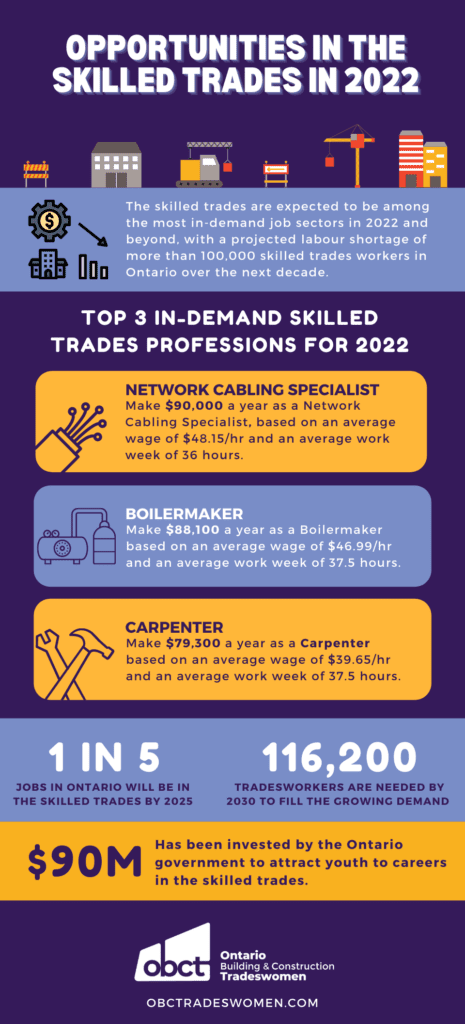“To learn a skilled trade is to have a job for life.” That is the pitch that the Government of Ontario and many in construction and building industries are promoting to attract more people to explore careers in skilled trades, which is expected to be among the most in-demand job sectors in 2022 and beyond. In fact, by 2025, as many as 1 in 5 jobs in Ontario will be in the skilled trades.
With a projected labour shortage of more than 100,000 skilled trades workers in Ontario over the next decade, and a significant four-year investment of more than $1.5 billion by Ontario’s Ministry of Labour, Training and Skills Development, there has never been a more opportune time to enter the skilled trades than right now.
As part of Ontario’s Skilled Trades Strategy to bridge the workforce shortage, there are a variety of introductory and apprenticeship programs, incentives, skills development, and support resources available to explore, whether you are a student in high school, starting a second career, or ready to take the next steps to financial security and a rewarding profession. Most apprenticeship programs can be completed within 3-5 years; plus, apprentices get paid while learning
The average starting wage of a journeyperson (someone who has completed their certification) is $40/hour; nearly 3X the minimum wage for most retail and food service jobs. Entry to most programs requires a high school diploma, and some programs require completion of certain courses like Grade 12 Math, English, or sometimes Physics; with some sectors, such as carpentry, that only require a minimum Grade 10 education in Canada, or proven equivalency.
The average age of people entering skilled trades is 29; however, the government of Ontario is hoping to lower the median entry age to 22. Most recently, Ontario committed another $90 million investment in the trades sector to attract more youth to skilled trades through the expansion of the Ontario Youth Apprenticeship Program (OYAP), which will add more recruiters in 800 schools across the province to teach young people about the skilled trades.
The program also provides free pre-apprenticeships training for marginalized youth, and a more simplified existing apprenticeship system to minimize barriers to entry. In addition to attracting more youth, there are specific programs for new immigrants who want to transfer their skills, as well as for women.
Women currently represent less than four per cent of workers in the most in-demand construction skilled trades; however, there are encouraging signs that the tides are changing, as governments and construction companies are realizing that women are essential to filling the skilled labour shortage.
There has been a dramatic increase to 34,800 women working in skilled trades in 2018, despite fewer people working in the trades in Canada overall. More and more women are seeing the benefits of working in skilled trades that offer competitive salaries, health benefits, and job stability, and satisfaction.
The Ontario Building and Construction Tradeswomen (OBCT), a committee of tradeswomen on a mission to educate underrepresented groups on the benefits of building a career in the skilled trades, says that breaking some of the misconceptions around the skilled trades is key to encouraging more women, persons with disabilities, and other marginalized groups to consider a career in skilled trades.
For example, not all skilled trades jobs require heavy lifting; most jobs emphasize transferable soft skills, such as problem solving, strong math and communications skills, hand-eye coordination, attention to detail, and ability to work in a collaborative environment.
As well, to support women and families, many trades associations offer benefits and financial assistance during pregnancy, parental leave, and return to work. The UA (Union of Plumbers, Steamfitters, Sprinkler Fitters, Welders, and HVAC Mechanics) offers its members who qualify, extended maternity leaves, financial support to help care for their newborn during their first year of life, and paid time off for members who are pregnant while working in the trades (as pregnancy progresses it may become difficult to continue working in particular environments associated with construction, such as being in high elevation). And, recently, the Government of Ontario also expanded its Skills Development Fund to include subsidized childcare support for trades workers.
With one of the largest investments by the provincial government to promote skilled trades, greater access to training and apprenticeships, financial incentives for employers and employees, job prospects in the skilled trades continue to be among the fastest growing and in-demand.









